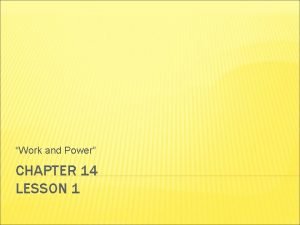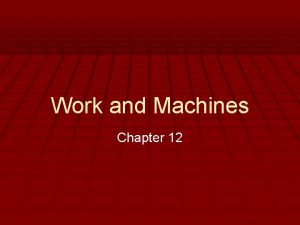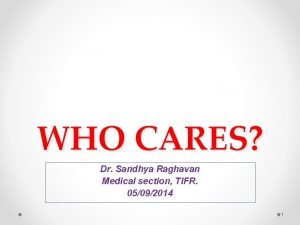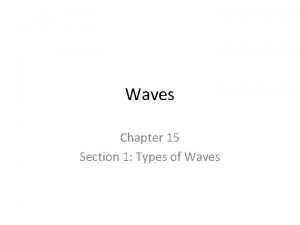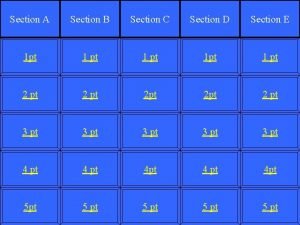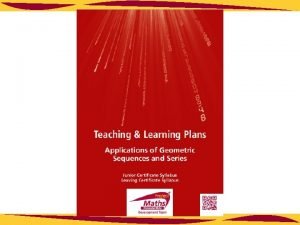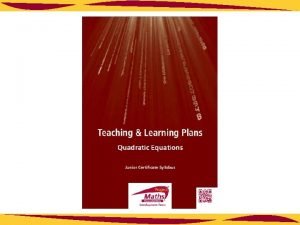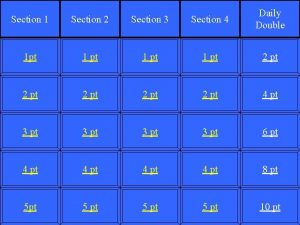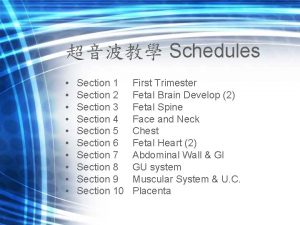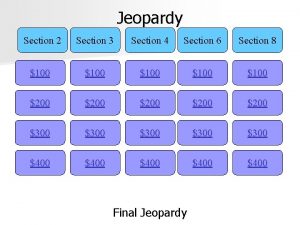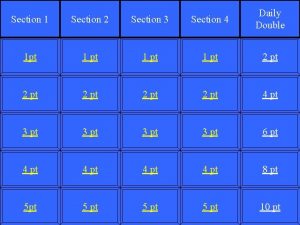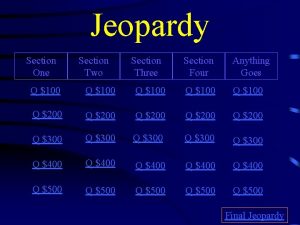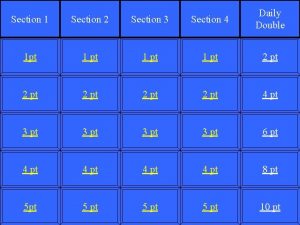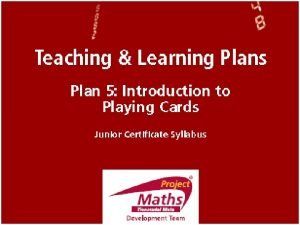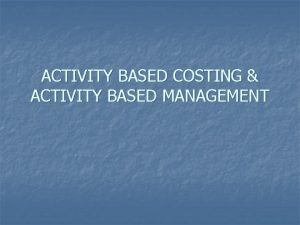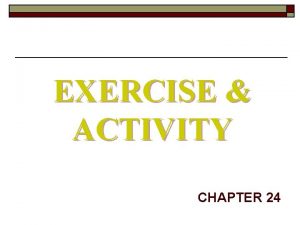Section A Activity 3 Activity 2 Activity 1
























- Slides: 24


Section A: Activity 3 Activity 2 Activity 1 Index Section B: Section C To further explore the concepts of geometric sequences including challenging student exercises

• What is a sequence? • Sequences can be finite or infinite. • Can you give me examples of sequences? • Are all sequences arithmetic? • Can you give me examples of sequences that are not arithmetic? • Do the first three questions in Section A: Student Activity 1 and use the results of these to complete Question 4. Lesson interaction Index Activity 1 Activity 2 Activity 3 Section A: Introduction

Index Activity 1 Activity 2 Activity 3 Section A: Student Activity 1 1. Nigel saves € 2 in the first week of the New Year, if he doubles the amount he saves every week after that, how much will he save in the 2 nd, 3 rd , 4 th and 5 th week of the year? a. Complete the following table and explain your reasoning: Week No. 1 st Week 2 nd Week 3 rd Week 4 th Week 5 th Week Amount Saved 2. The price of an item trebles on the first day of every month. It costs € 2. 00 on the 1 st January, calculate its cost on the first day of the following four months a. Complete the following table and explain how you got your calculations: Date. Cost 1 st February 1 st March 1 st April 1 st May

Index Activity 1 Activity 2 Activity 3 Section A: Student Activity 1 3. A town had a population of 100. In January 2010, A new factory was being built in the town and consequently, the local authority expected that the town’s population would increase by 20% year-on-year for the next 5 years. a. Explain clearly how the town’s population in January 2011 is calculated? b. Complete the following table and explain your reasoning: Date. January 2011 January 2012 January 2013 January 2014 January 2015 Population 4. Examine the completed tables from the previous three questions. a. Do the numbers you calculated follow any particular pattern in each table? b. Can you generate a formula to calculate the entries in each of the tables?

• The number that we multiply the first term by to get the second term is known as r, the common ratio. In terms of a and r what is T 1 ? In terms of a and r what is T 2 ? In terms of a and r what is T 3 ? In terms of a and r what is T 4 ? In terms of a and r what is Tn ? This formula can be found on page 22 of the formula and tables booklet. It can be used to find the general term of any geometric sequence. • What type of number is n? Why? Lesson interaction • What did we call the first term when dealing with sequences previously? Page 22 • What did the first three questions have in common? • Sequences generated in this manner are known as a geometric sequence. Page 23 Index Activity 1 Activity 2 Activity 3 Section A: Student Activity 1

• What name can also be given to the type of pattern produced in a geometric sequence? • Do geometric sequences form an exponential pattern? • When r is a proper fraction, we have exponential decay rather than growth? • Give an example of a geometric sequence that represents exponential decay? • Complete the remaining exercises in Section A: Student Activity 1. Lesson interaction Index Activity 1 Activity 2 Activity 3 Section A: Student Activity 1

Index Activity 1 Activity 2 Activity 3 Section A: Student Activity 1 1. Nigel saves€ 2 in the first week of the New Year, if he doubles the amount he saves every week after that, how much will he save in the 2 nd, 3 rd , 4 th and 5 th week of the year? 2. The price of an item trebles on the first day of every month. It costs € 2. 00 on the 1 st January, calculate its cost on the first day of the following four months 5. Assuming the patterns in Questions 1 and 2 (above) continue, complete the table below. It is not necessary to evaluate the powers. Question 1 Amount saves in the 50 th month Amount saves in the 100 th month Question 2 Population in January 2020 Population in January 2040 For question 1 above what does T 50 mean?

Index Activity 3 Activity 2 Activity 1 Section A: Student Activity 1 1 st Bounce 2 nd Bounce 3 rd Bounce 4 th Bounce 5 th Bounce

Index Activity 1 Activity 2 Activity 3 Section A: Student Activity 1 9. Seven houses each contain seven cats. Each cat kills seven mice. Each mouse had eaten seven ears of grain. Each ear of grain would have produced seven hekats of wheat. (The hekat was an ancient Egyptian volume unit used to measure grain, bread, and beer. ) © http: //www. daviddarling. info/encyclopedia/R/Rhind_papyrus. html Complete the table below and describe the type of sequence formed by numbers. Houses Cats Mice Ears of Grain Hekats b. Give the general formula that could be used to generate these numbers. 10. A local club lottery offers a standard first prize of € 50 and there is one draw each week. If there is no winner the prize doubles for the following week. This pattern continues until the first prize is won. How much would the first prize be worth if there was no winner for (a) six consecutive weeks and (b) six consecutive months? Show your calculations. 11. If € 1, 000 is invested at 5% compound interest (assume for this problem the interest accrues on the anniversary of lodgement date. ) How much will be in the account after 4 years? Show your calculations.

Index there are four possible outcomes and so on. How many outcomes are there if the coin is tossed three times? Now complete the table below, (show your calculations): No. of Tosses 10 15 20 30 Activity 2 No. Of Outcomes 13. An antique costing € 4, 000 appreciates each year by 6% of the value it was at the beginning of that year. Find its value after 11 years. Show your calculations. Activity 3 Activity 1 Section A: Student Activity 1 12. When a coin is tossed there are two possible outcomes, if it is tossed twice 14. The value of a car depreciates at an annual rate of 5%. If the car initially cost € 25, 000, find: a. its value at the end of the first year (show your calculations) b. its value after 8 years? (show your calculations) 15. A frog wants to hop a total distance of 1 metre. The first hop is 1/2 metre in length, the second is 1/4 metre and the third is 1/8 metre. If this pattern continues: a. what will be the length of the 9 th hop? b. how many hops will it take for the frog to travel a total distance of 1 m? (Think carefully before you answer this one. )

Index Activity 1 Activity 2 Activity 3 Section A: Student Activity 1 16. The number of pupils in a school increases at the rate of 5% per annum. When the school opened there were 200 pupils on the roll. How many pupils will there be in the school on the 10 th anniversary of the opening? 17. A novice swimmer can complete the 50 m breaststroke in 36 s. He follows a programme designed to increasing improve his performance by 4% each year. How fast will he complete the 50 m breaststroke after six years of the programme? 18. Tabulate the y coordinate in each case for the graphs to the right and decide in each case if the y co-ordinates form a geometric sequence. Give a reason for your answer in each case. Graph 1 Graph 2

• What do a, r and n stand for in relation to geometric sequences? • What is the formula for the general term of a geometric sequence? Lesson interaction Index Activity 1 Activity 2 Activity 3 Reflection

• What do a, r and n represent in this formula? • Working in pairs list as many applications of geometric sequences as possible. • Do the activities contained in Section B: Student Activity 2. Lesson interaction • What is the formula for the nth term of a geometric sequence? Page 22 • What is a geometric sequence? Page 23 Index Activity 1 Activity 2 Activity 3 Section B: Introduction

Index Activity 1 Activity 2 Activity 3 Section B: Student Activity 2 (Calculations must be shown in all cases. ) 1. There is a legend that tells how an Indian king promised the inventor of the chessboard a grain of rice for the first square of a chessboard, 2 for the second, 4 for the third, 8 for the fourth square etc. (Note a chessboard has 64 squares). http: //www. expert-chess-strategies. com/who-invented-chess. html a. What weight of rice was on the first square if one grain of rice weighs 20 mg? b. What weight of rice was on the second square if one grain of rice weighs 20 mg? c. What weight of rice was on the fourth square if one grain of rice weighs 20 mg? d. What weight of rice was on the tenth square if one grain of rice weighs 20 mg? e. What weight of was in the last square of the board, if one grain of rice weighs 20 mg? f. Does the weight of rice on consecutive squares of the cheeseboard constitute a geometric sequence? Explain why.

Index Activity 1 Activity 2 Activity 3 Section B: Student Activity 2 2. As I was going to St. Ives, I met a man with seven wives. Every wife had seven sacks, and every sack had seven cats, every cat had seven kittens. © http: //www. daviddarling. info/encyclopedia/S/St_Ives_problem. html a. How many wives did I meet? b. How many sacks did I meet? c. How many cats did I meet? d. How many kittens did I meet? e. Do these numbers constitute a geometric sequence? Explain why. 3. If the perimeter of the equiangular triangle ABC is x cm. The mid points of the sides are joined to form a smaller triangle and the process goes on as in the diagram. If the perimeter of the 6 th triangle is 3 cm. Find the value of x. 4. If 1, 024 tennis players enter a tournament. How many matches must be played in the 6 th round if in the tournament the winner of each match moves to the next round and the loser of each match is removed from the tournament?

Index Activity 1 Activity 2 Activity 3 Section B: Student Activity 2 5. The first week of July was the busiest week of the year at the Deluxe Hotel. It had 200 guests that week. In the weeks immediately following this, the bookings decreased by 5% each week. How many guests did the hotel have in the 10 th week following its busiest week? 6. In a geometric sequences when will the value of terms decrease? When will they increase? 7. A culture of bacteria doubles every 2 hours. If there are 400 bacteria in the culture on a given day, how many bacteria will there be at the same time the following day? 8. If the graph opposite represents the first 4 terms in a T n geometric sequence, create a story that could be represented by the graph. What values have a and r in the sequence? n

Index Activity 1 Activity 2 Activity 3 Section B: Student Activity 2 9. If a, the first term of a geometric sequence is equal to 10 and r, the common ratio is ½, draw a graphical representation of this geometric sequence. 10. An employee has a starting salary of € 20, 000 and can choose from two salary options: Option 1: A salary increase by 5% each year. Option 2: A guaranteed increase of € 1, 000 each year. a. Which option is initially more beneficial? b. Which option is more beneficial after 10 years of employment? c. Explain your reasoning. 11. A line segment is divided into six parts forming a geometric sequence. If the shortest length is 3 cm and the longest is 96 cm, find the length of the line segment. Show your calculations.

Index Activity 2 12. A local authority decided to control a pest infection in an area by trapping the pests, it was initially estimated that there were 12, 000 of these pests in the area and the daily rate of trapping is 1% of the number that exist at the beginning of that particular day. a. What is the expected number of pests that will be trapped on the first day? Activity 3 Activity 1 Section B: Student Activity 2 c. What is the expected number trapped on the 10 th day? b. What is the expected number of pest that will exist after the 1 st day? d. What is the expected number of pests that will exist after the 10 th day of trapping? e. What is the total number of pests trapped after 5 days? f. What is the population of the pests in this area after 5 days?

Activity 2 Lesson interaction Activity 1 Index Lesson interaction Activity 3 Section C: Introduction

Activity 3 Activity 2 Activity 1 Index Section C: Student Activity 3

Activity 3 Activity 2 Activity 1 Index Section C: Student Activity 3

Activity 3 Activity 2 Activity 1 Index Section C: Student Activity 3

Index Activity 1 Activity 2 Activity 3 Section C: Student Activity 3 12. A four year old car is valued at € 16, 038. 00. A year later the same car is valued at € 14, 434. 20. If the value of the car continues to depreciate at a fixed annual rate. Find the original value of the car correct to the nearest euro.
 Full sectional view
Full sectional view What is revolved section
What is revolved section Example
Example What is the definition of chemical potential energy
What is the definition of chemical potential energy Section quick check chapter 10 section 1 meiosis answer key
Section quick check chapter 10 section 1 meiosis answer key Chapter 1 foundations of government worksheet answers
Chapter 1 foundations of government worksheet answers Reactant products and leftovers
Reactant products and leftovers Activity and activity coefficient
Activity and activity coefficient Aon vs aoa
Aon vs aoa Activity 1 introductory activity
Activity 1 introductory activity Activity 1 activity 2
Activity 1 activity 2 Activity 2 identifying the pattern
Activity 2 identifying the pattern Activity 1 activity 2
Activity 1 activity 2 Worm heart
Worm heart World war 2 and its aftermath section 3 quiz
World war 2 and its aftermath section 3 quiz Chapter 17 section 3 luther leads the reformation
Chapter 17 section 3 luther leads the reformation Chapter 30 section 2 world history
Chapter 30 section 2 world history Chapter 15 section 2 world history
Chapter 15 section 2 world history Chapter 10 section 2 central america and the caribbean
Chapter 10 section 2 central america and the caribbean Unit 14 lesson 1 drivers ed
Unit 14 lesson 1 drivers ed Section 1 work and machines answer key
Section 1 work and machines answer key Wilson fights for peace
Wilson fights for peace Tifr medical section
Tifr medical section Chapter 15 section 1 types of waves answer key
Chapter 15 section 1 types of waves answer key Chapter 24 section 2 watergate answers
Chapter 24 section 2 watergate answers



















